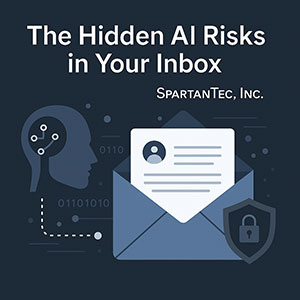 Artificial Intelligence has changed how we work, especially when it comes to email. From AI-powered writing assistants to automated spam filters and chat integrations, your inbox is smarter than ever.
Artificial Intelligence has changed how we work, especially when it comes to email. From AI-powered writing assistants to automated spam filters and chat integrations, your inbox is smarter than ever.
But as with every new technology, there’s a catch. The same AI tools that help you communicate faster are also being used by attackers to make their messages more convincing — and harder to detect.
Let’s look at what’s hiding inside today’s inboxes, and what your business can do to stay safe.
- AI-Written Phishing Emails
Gone are the days of broken English and obvious scams. Attackers now use AI language models to craft personalized, professional-looking emails that perfectly mimic real people, clients, or vendors.
These messages can include accurate signatures, tone, and context — making even experienced employees second-guess themselves.
How to protect your team:
- Enable advanced phishing protection.
- Train employees to verify any unexpected requests for wire transfers, password resets, or data sharing.
- Use multi-factor authentication to prevent stolen credentials from being reused.
- Deepfake Attachments and Links
AI can generate realistic documents, invoices, or even audio recordings that appear authentic. Attackers use this to trick recipients into opening infected files or visiting malicious websites that look legitimate.
Protective measures:
- Block executable file types and scan all attachments.
- Hover before you click — confirm every URL before visiting.
- Use sandboxing and endpoint protection to detect hidden payloads.
- Compromised Email Filters
Ironically, the AI filters meant to protect you can also be manipulated. Attackers have learned to “train” spam filters by gradually adjusting the content of their emails to bypass AI detection.
Defense strategies:
- Review email filtering policies regularly.
- Integrate AI-based protection with human review and alerting.
- Use layered security — not just the default filter in Microsoft 365 or Google Workspace.
- AI Tools That Mishandle Email Data
Employees increasingly rely on AI assistants to summarize emails, draft replies, or analyze customer messages. While convenient, many of these tools store content in external servers. That can expose private information if the platform lacks enterprise-grade security.
Keep it safe:
- Only use company-approved AI integrations.
- Avoid connecting personal Gmail or Outlook accounts to unvetted AI extensions.
- Work with your IT provider to control permissions and data retention policies.
- Social Engineering on a New Level
AI doesn’t just generate messages — it learns from them. Attackers can analyze your public communication patterns to create spear-phishing emails that sound exactly like you or your CEO.
Stop impersonation attempts:
- Implement domain-based message authentication (DMARC, DKIM, SPF).
- Use internal verification phrases for sensitive requests.
- Monitor for look-alike domains attempting to spoof your brand.
Your Inbox Is the New Front Line
AI is changing the rules of cybersecurity — and your inbox is one of the first battlefields. Every employee, from the front desk to the boardroom, faces AI-driven attacks designed to look authentic.
SpartanTec helps protect your business from AI-powered threats with layered security, managed email protection, and real-time threat detection through our SecureGuard360 platform.
Ready to find out how secure your inbox really is?
Schedule your Email & AI Threat Assessment with SpartanTec today.


